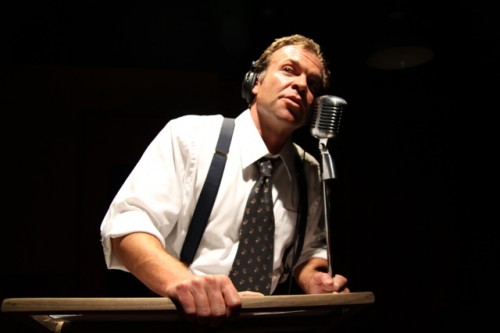
Regen Wilson as Orson Welles in SCENA Theatre's "War of the Worlds." Photo credit: Ian C. Armstrong.
As a child one of my favorite Halloween activities was listening to a taped radio rebroadcast of The War of the Worlds. In my memory it’s always during a power outage, candles flickering, my father scaring us kids even more by playing scratchy old records afterwards on a creepy vintage Victrola. Though the voice of Orson Welles instantly connected me to primal fear, there was always something in that rumbling tone that felt safe, an underlying comic lifeline, a wink. But my father made sure to explain that wink got Welles in a hell of a lot of trouble.
In SCENA Theatre’s recreation of the October 30, 1938 broadcast, Regen Wilson nails that Wellesian voice just right. But the production itself is too faithful to a fault. Simply too much of a recreation, it strangely fails to mine the greater implications of the original broadcast. It feels like a dusty museum piece, playing to an almost empty house the night I visited. Talented actors, a fine production design, all on display for what purpose? When one can download the original in a few minutes and be frightened by Welles himself, what could the intent of such a performance be?
That almost empty house preyed on my mind while writing this review. There is no worse feeling when you love theater. But I have to be honest, all that reverential recreation made for a dry night out. The confines of this conceit are just too restraining for SCENA, which only released itself into what it does best – chaotic surrealism – in the final minute. It all adds up to lost opportunities. And considering this is a remount of their 2006 production, the safe choices are even more mystifying.
At first glance, this seems a respectable production to introduce you to Welles’ infamous prank about a Martian invasion. It’s well-acted with good production values, taking up an easy hour of your time in the H Street Playhouse. You’re watching the infamous radio broadcast from behind-the-scenes, with Welles and actors interplaying as both performers and people in the studio. It’s meant to be a slice of realism (look! actors eat doughnuts backstage! see how they joke and heckle each other!) but serves mainly as a distraction. The only spoken deviation from the original script comes in asides from actors in the audience detailing the hysteria that ensued from listeners who thought the broadcast was real. Unfortunately, these asides seem more jarring than exploratory, and there are still valid questions about the broadcast that would be more fascinating to explore.
Was there truly a panic, and how large was it really? What was the role and intent of the newspapers’ outrage afterwards? Were they reporting real news or did they feel threatened by the new medium of radio? Was it all a harbringer of the eventual battle royale between Welles and Hearst, new media vs. old media, that we are still engaged in today? In an era where live theater’s existence is threatened by the virtual, that’s the play to produce. And those underlying questions on the true power of both the media and the impresario are especially pertinent today, when people are too trusting of misinformation yet again.
Regen Wilson is definitely a standout here, with the cadences of Welles and his mercurial simmer intact. His turn as Welles-as-Professor-Pierson observing the apocalyptic post-invasion world is gripping, taking command for a moment. The rest of the ensemble is well-suited to recreating the vocal ambience of the 1930’s; the radio cast especially is pitch-perfect with those historical accents.
Again, it’s not the performers themselves, but the intention of the production that falls flat. At times I just wanted to lights to go out, to be free from the doughnuts and the asides, and recapture the Pied Piper magic of Welles’ voice scaring and soothing me as a child. If I couldn’t have a more imaginative retelling, ironically, I wanted the real thing.
SCENA Theatre’s The War of the Worlds now through November 28 at H Street Playhouse, 1365 H Street NE, Washington, DC 20002. For more information call 703-683-2824.

